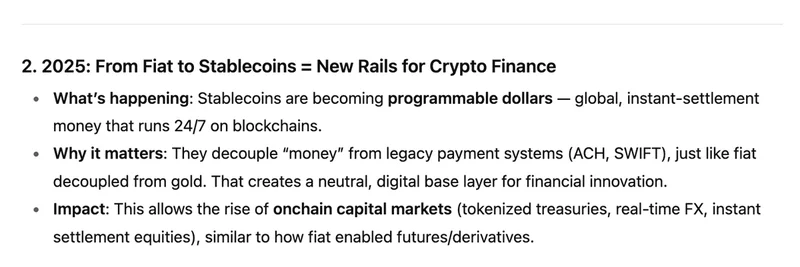Ever wondered how historical financial shifts could predict the future of crypto? A recent tweet from Token Terminal draws a fascinating parallel between the end of the gold standard in 1971 and the rise of stablecoins in 2025. This isn't just history repeating itself—it's a blueprint for explosive growth in crypto finance, including the wild world of meme tokens. Let's break it down step by step.
The Historical Parallel: From Gold to Fiat in 1971
Back in 1971, President Nixon shocked the world by ending the U.S. dollar's convertibility into gold. This move untethered monetary policy from physical constraints, allowing central banks to respond more dynamically to economic needs. Suddenly, Wall Street had room to innovate with derivatives, foreign exchange (FX) markets, and structured products. The result? A technology-driven boom in finance, with electronic trading and global capital flows taking center stage.
This shift turned finance from a rigid system into a flexible powerhouse, enabling new forms of capital markets that we take for granted today.
The Crypto Shift: From Fiat to Stablecoins in 2025
Fast forward to today, and stablecoins are doing something similar for crypto. These digital dollars—pegged to fiat currencies like the USD—are becoming programmable money that runs 24/7 on blockchains. According to the tweet, stablecoins decouple "money" from outdated payment systems like ACH and SWIFT, creating a neutral, digital base layer for innovation.
Why does this matter? Just like fiat freed finance from gold, stablecoins are freeing crypto from legacy rails. This paves the way for onchain capital markets, including tokenized treasuries, real-time FX, and instant-settlement equities. Imagine trading assets around the clock without intermediaries— that's the future we're heading toward.
The Rhyme of History: Constraints to Freedom
Token Terminal sums it up with a neat table highlighting the "historical rhyme":
- Pre-1971: Constraint was the gold standard; breakthrough came with fiat currencies; innovations enabled included derivatives, FX, and modern global markets.
- Pre-2025: Constraint is legacy rails (bank wires, ACH, SWIFT); breakthrough is stablecoins (programmable fiat); innovations enabled are onchain finance and 24/7 capital markets.
This isn't just theory—it's happening now. As Fundstrat discussed in their recent episode, this could even turn traditional giants like JPMorgan into tech stocks, blending banking with blockchain.
What This Means for Meme Tokens
At Meme Insider, we're all about meme tokens, so let's connect the dots. Stablecoins aren't just for stable trading; they're the rails that make meme token ecosystems thrive. With instant settlements and 24/7 access, meme coins can go viral globally without the friction of traditional finance. Think about it: pumps, dumps, and community-driven hype happen in real-time, fueled by programmable money.
For blockchain practitioners, this means easier liquidity pools, decentralized exchanges (DEXs), and cross-chain swaps. Meme tokens, often dismissed as jokes, could become serious players in onchain finance. Projects like Dogecoin or newer entrants can leverage stablecoin integrations for better stability during volatile runs, attracting more investors.
Plus, with tokenized assets on the rise, meme tokens might evolve into hybrid instruments—combining fun narratives with real utility, like yield-bearing memes or NFT-backed coins.
Looking Ahead: Opportunities in Onchain Finance
The tweet from Token Terminal isn't just insightful; it's a call to action. As stablecoins become the new standard, expect a surge in innovations that benefit everyone from retail traders to institutional players. For meme token enthusiasts, this is prime time to dive deeper—build your knowledge base, track emerging projects, and stay ahead of the curve.
If you're into the nitty-gritty, check out the full Fundstrat discussion linked in the thread. It's packed with insights on how crypto is rebirth-ing Wall Street.
What do you think—will stablecoins supercharge meme tokens like fiat did for derivatives? Drop your thoughts in the comments!



